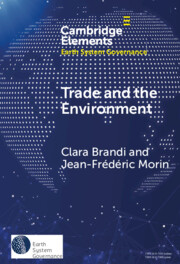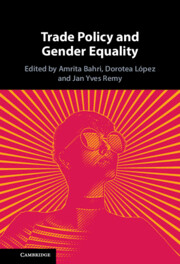Refine search
Actions for selected content:
45 results
An opportunity to remove harmful intellectual property provisions from the Comprehensive and Progressive Agreement for Trans-Pacific Partnership
-
- Journal:
- Health Economics, Policy and Law , First View
- Published online by Cambridge University Press:
- 26 November 2025, pp. 1-8
-
- Article
-
- You have access
- Open access
- HTML
- Export citation
2 - Globalisation, Free Trade and Labour Law
- from Part I - Introduction
-
- Book:
- Labour Law
- Published online:
- 02 October 2025
- Print publication:
- 20 November 2025, pp 46-94
-
- Chapter
- Export citation
5 - Lobbying over Trade Policy in the European Union
-
- Book:
- Every Firm for Itself
- Published online:
- 21 July 2025
- Print publication:
- 07 August 2025, pp 87-115
-
- Chapter
- Export citation
4 - Making Trade Agreements Work for Women:
-
-
- Book:
- Globalization in Latin America
- Published online:
- 09 June 2025
- Print publication:
- 26 June 2025, pp 56-78
-
- Chapter
-
- You have access
- Open access
- HTML
- Export citation
5 - Assessing Special and Differential Treatment in Latin American Trade Agreements
-
-
- Book:
- Globalization in Latin America
- Published online:
- 09 June 2025
- Print publication:
- 26 June 2025, pp 79-102
-
- Chapter
-
- You have access
- Open access
- HTML
- Export citation
12 - Trade Protectionism and Integration in Latin America
-
-
- Book:
- Globalization in Latin America
- Published online:
- 09 June 2025
- Print publication:
- 26 June 2025, pp 255-289
-
- Chapter
-
- You have access
- Open access
- HTML
- Export citation
14 - Taking Climate Change Seriously in the Design of Trade Agreements
-
-
- Book:
- The Concept Design of a Twenty-First Century Preferential Trade Agreement
- Published online:
- 04 April 2025
- Print publication:
- 06 March 2025, pp 316-339
-
- Chapter
-
- You have access
- Open access
- HTML
- Export citation
Operationalizing Package Treaties: A US Case Study
-
- Journal:
- World Trade Review / Volume 23 / Issue 5 / December 2024
- Published online by Cambridge University Press:
- 13 January 2025, pp. 589-600
- Print publication:
- December 2024
-
- Article
-
- You have access
- Open access
- HTML
- Export citation
Identifying Spillovers of Trade Agreements through Impact Assessments: A New Database
-
- Journal:
- World Trade Review / Volume 23 / Issue 5 / December 2024
- Published online by Cambridge University Press:
- 13 January 2025, pp. 573-588
- Print publication:
- December 2024
-
- Article
-
- You have access
- Open access
- HTML
- Export citation
An Economic Assessment of the EU–Japan Economic Partnership Agreement with Realistic Preference Utilization Rates
-
- Journal:
- World Trade Review / Volume 24 / Issue 1 / February 2025
- Published online by Cambridge University Press:
- 15 November 2024, pp. 1-24
- Print publication:
- February 2025
-
- Article
-
- You have access
- Open access
- HTML
- Export citation
Clive Palmer’s claims against Australia for billions renew pressure to remove investor rights to sue governments from trade agreements
-
- Journal:
- The Economic and Labour Relations Review / Volume 35 / Issue 2 / June 2024
- Published online by Cambridge University Press:
- 03 September 2024, pp. 454-466
-
- Article
-
- You have access
- Open access
- HTML
- Export citation

Trade and the Environment
- Drivers and Effects of Environmental Provisions in Trade Agreements
-
- Published online:
- 07 December 2023
- Print publication:
- 21 December 2023
-
- Element
-
- You have access
- Open access
- HTML
- Export citation
6 - International Data Transfers and Cybersecurity
-
-
- Book:
- Public and Private Governance of Cybersecurity
- Published online:
- 09 November 2023
- Print publication:
- 23 November 2023, pp 134-160
-
- Chapter
- Export citation
Gender Equality Provisions in Trade and Investment Agreements: Are They Widening the Negotiation Capacity Gap?
-
- Journal:
- World Trade Review / Volume 23 / Issue 1 / February 2024
- Published online by Cambridge University Press:
- 16 November 2023, pp. 47-71
- Print publication:
- February 2024
-
- Article
- Export citation
9 - Mainstreaming Gender in Investment Treaties and Its Prevailing Trends
- from Part II - Current Issues in Gender Equality and Trade Policies
-
-
- Book:
- Trade Policy and Gender Equality
- Published online:
- 05 October 2023
- Print publication:
- 19 October 2023, pp 194-212
-
- Chapter
-
- You have access
- Open access
- HTML
- Export citation
1 - Introduction
-
-
- Book:
- Trade Policy and Gender Equality
- Published online:
- 05 October 2023
- Print publication:
- 19 October 2023, pp 1-18
-
- Chapter
-
- You have access
- Open access
- HTML
- Export citation
2 - Gender-Responsive WTO
- from Part I - The WTO and Gender Equality
-
-
- Book:
- Trade Policy and Gender Equality
- Published online:
- 05 October 2023
- Print publication:
- 19 October 2023, pp 21-43
-
- Chapter
-
- You have access
- Open access
- HTML
- Export citation

Trade Policy and Gender Equality
-
- Published online:
- 05 October 2023
- Print publication:
- 19 October 2023
-
- Book
-
- You have access
- Open access
- Export citation
12 - China and WTO Reform
- from Part III - China and Global Trade Governance
-
-
- Book:
- China and the WTO
- Published online:
- 14 September 2023
- Print publication:
- 28 September 2023, pp 275-298
-
- Chapter
-
- You have access
- Open access
- HTML
- Export citation
NET ZERO EMISSIONS AND FREE TRADE AGREEMENTS: EFFORTS AT INTEGRATING CLIMATE GOALS BY THE UNITED KINGDOM AND AUSTRALIA
-
- Journal:
- International & Comparative Law Quarterly / Volume 72 / Issue 2 / April 2023
- Published online by Cambridge University Press:
- 28 April 2023, pp. 393-436
- Print publication:
- April 2023
-
- Article
-
- You have access
- Open access
- HTML
- Export citation
